There was no meltdown at Blue Sky Studios when it came to creating all-new fur and water technology for its Ice Age sequel. Bill Desowitz gets the scoop from first-time director Carlos Saldanha and others. Includes a QuickTime clip!
If you have the QuickTime plug-in, you can view a clip from the film by simply clicking the image.
Part of the great charm and success of Ice Age was its simplicity, including the animation. In fact, because of budgetary constraints, director Chris Wedge had virtually no money for environment and effects for Blue Skys first feature. But now, four years later, with 3D animation becoming such a booming industry and technology improving so resoundingly, New York-based Blue Sky Studios, already known for its ray tracing prowess, was ready for a more ambitious technical challenge with Ice Age: The Meltdown (a Twentieth Century Fox Animation production opening March 31).
With Wedge following up with last years Robots, Carlos Saldanha took over as director of The Meltdown. As co-director of both Ice Age and Robots, Saldanha offered a more physical approach to the comedy and animation, especially given the environmental jeopardy inherent in the sequel. (This time, Manny, Sid and Diego confront pre-historic global warming and flee for the other side of the valley before the great glacial dam breaks. Along the way, Manny, whos convinced hes extinct, meets his match in Ellie, a Mammoth, voiced by Queen Latifah, who thinks shes a possum. And, by the way, theres much more Scrat in this one too.) However, because of new constraints, Blue Sky had eight months to complete The Meltdown. That was less time than it had on Ice Age with proportionally the same budget. Fortunately, there were 60 animators on this movie compared to 35 on the first Ice Age.
We embraced the fact that the movie could look simpler and the characters and story could stand out, Saldanha suggests. In a way, I wanted to embrace that on this one because its still about the characters. We had a more complex story in terms of the effects because of the meltdown, so we had to work harder on the elements and the fur. We wanted to make the fur better and we wanted to have interaction, so we wanted to use the fur almost like another character. So we had to face all those challenges with the constraints of money and time. At first, I didnt think we could have all these shots, but we kept fighting the schedule and kept making them [happen]. I think the audience has matured since the time of the first Ice Age, and we wanted to give them some fresh elements. And because the industry has matured, we wanted to make sure that we were right there [with the best of them]. So we wanted to add this level of complexity that fit right along with the story, which is very unique for us because were not used to doing a lot of effects in our animation.
Thus, as a result of the achievements on Robots, with its great emphasis on surface textures and elaborate environments, Blue Sky developed additional texture mapping and environmental techniques propagation, as animators call it. And because of the nature of The Meltdown, propagation helped fulfill all the requirements for trees and grass to fill the environments. We pushed the envelope with the animation on this one, Saldanha boasts. This fur technique completely solved the issue for us. We could have Scrat completely stretch like he does in the end.
In fact, Saldanha is very proud of drawing out more physical performances from Scrat and the other characters during moments of jeopardy in The Meltdown. Thus, at a moment when too much talking dominates animated features, the director and his crew remind us that pantomime is one of animations greatest strengths.
In terms of pure animation, Ellies moving and pretty flashback is very special to the director. The whole movie takes place in springtime and has very lush forests, very green, with very little ice, and I wanted that flashback to feel like the old times and create a wintry scene with snowstorms and drifts. Even the present day segue was beautiful and that was a challenge to come up with those willow trees. At the last minute, I wanted willow trees because every branch had to move with the wind and we had to come up with a way of doing it, so the guys did a lot of texture mapping with cards.
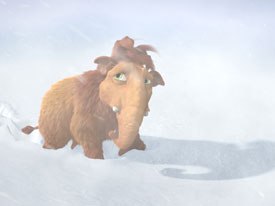
Another aesthetic standout for Saldanha is Scrats heavenly encounter, a lot of which was painted by hand. I wanted it to feel a little more angelic, a Renaissance feel. The golden clouds were a combination of 3D and 2D. We worked very hard with our art director [Thomas Cardone] and lighting director [David Esneault] to get the right mood. They have such a great eye for bringing a painterly feel to the project. It all starts with the painting. We have these amazing artists that create thumbnails with color. They bring so much warmth and life to the frame that I wanted it to be transported to this world.
But before Saldanha could transport and delight us, a lot of technical groundwork first had to be completed. After several years of R&D at Blue Sky, the team was able to perfect fur and water to advance the animation demands of The Meltdown.
Our fur technology on Ice Age was essentially sprite cards with an image of fur, recounts Fur and Feathers supervisor Eric Maurer. I worked on that film and developed a procedural grooming approach for Diego and the cats. When we started Ice Age 2, in the interim, our R&D department under [software manager] Maurice Van Swaaij had developed a voxel rendering system for hair. We even used an early version of it on the first Ice Age for the human hair. But because of the large RAM footprint and the fact that it was very beta technology, we werent able to use it overall.
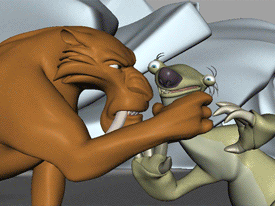
But he made tremendous improvements in that and computers also got a lot more powerful. This allows us to draw every single hair in 3D space and then voxelize it [a voxel is a volume pixel a little cube in space that stores a value]. And we needed to develop a grooming technique to go with it. So we developed a procedural approach that is very different from other packages that tend to be action-based or painterly approaches. A procedural approach allows us to establish an archetype for one character and then we can transpose this procedural rig to similar characters of the same species. It proved to be a flexible system. So we essentially have a node-based network and a 3D interface where we create a set of tools to describe a vector field over the body to describe the principle hair direction, but then we have a 3D compositing setup where we have spots and splines in space to describe different aspects of the hair where its short, where its long, where its curly, where it lies flat. We start with grooming in world space and then transpose that into surface space so that we can manipulate the hairs relative to the characters surfaceand then essentially write a large data file, which describes all the millions of hairs point-by-point. That large data file is what we feed into the renderer.
Maurer adds that this is exciting from an animation process as well. Scrat has about 2,000,000 hairs on him and we would pull out of that roughly 2,000 hairs to be rig hairs, which would go through the rigging department through a proprietary tool we call Follow Through, which Adam Burr wrote. He presented it at SIGGRAPH after Ice Age to show how ears wiggle and hairs flap automatically. He expanded that to be fur Follow Through, where he can manipulate all of the 2,000 rig hairs on Scrat and the animators have control for their behavior. They have gravity, wind, turbulence, a stiffness cycle in decay times.
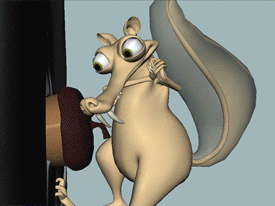
So on the teaser where you see Scrat climb up the glacier wall and caress the nut, Carlos directed the animators to have a little light gust of wind come up, so that was the first time Carlos was able to direct the fur behavior as well as the primary action of the character. On the second teaser, with the piranhas, where Scrat goes underwater, the animators could describe the way the fur behaves underwater. It doesnt have gravity anymore; it flows, and when he gets out of water, they could describe the wet behavior of the fur. Its heavier and moves differently. As well as the fur grooming stage, we developed a wet look for Scrat, where the fur clumps together and is denser because its water soaked.
Our highest hair count was on the Diatryma bird, which had 10,000,000 hairs. We did feathers also. One of the fun things was that [character designer] Peter De Sève had designed several birds for the first film that we didnt have time to use, so he pursued some bird designs for this one. Diving birds, prehistoric penguins, a baby condor, all the vultures as well as the Diatryma, so that forced us to push the fur technology to be our feather technology, and we developed elaborate procedural grooming techniques, where we took a bunch of hairs and pushed them into place to become a single feather. That held up rather well, even under motion.
Then there was the challenge of designing the vast water world. Water was always difficult, but we always knew that our water was good, the director emphasizes. The question was if we could make a lot of water look good. But I wanted the water to look real but have a little stylization to it. Some of the splash was even hand animated. We used a technique to create splashes that had an old Disney-like look to them.
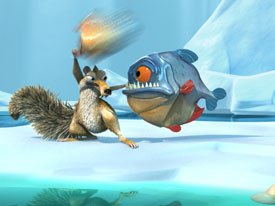
Achieving the water demands fell to effects supervisor Robert Cavaleri, whose effects team animated 1,158 effects elements, which were included in 602 total shots.
Theres not a lot of software out there for dealing with water, and the expectation of whats commercially available is that its very slow to animate and very expensive to render, Cavaleri concedes. We knew from the start that one of the key things we needed to do to make this successful was to have a lot of control over the water, so that meant that we would probably not want to simulate the water everywhere. While physically-based simulations yield technically correct results, they often lack the animation control necessary to stylize or direct the animation performance creatively. We wanted to come up with a stylized look that made sense for the Ice Age world. We knew we had to make the movie in less than a year and come up with clever techniques that looked good for the world but allowed us to keep a good pace to meet the schedule.
We did use some off-the-shelf software: Next Limits RealFlow for very specific situations, like the big dam break, to perform a simulation for the big effect. Another place we used RealFlow was when actors were playing and frolicking in the water park, with water running down the slide and a ripple effect when characters were swimming. The rest of the movie we used a range of techniques, including bump map and surface noise to displace the water for more calm environments, and a procedural animation approach for larger waves and higher amplitude water with a Maya plug-in written by one of our tds, Simon Bown, who also created the waves technique.
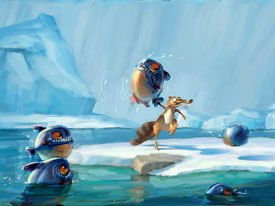
Meanwhile, John Thornton, a 2D animator from Disney (Lilo & Stitch, The Lion King), came up with a clever technique to create splashes that allowed you to essentially keyframe very basic geometric shapes and for particles to be leveraged off that system. But the beauty of this whole thing, according to Cavaleri, was that the rig allowed you to sculpt exactly what you wanted the splash to look like: every single detail in terms of the number of columns, the whole profile shape and the leading edge. With this system, for example, you could create an opening to get a really strong read on a characters performance yet still get all of the playful or possibly perilous interaction that youd expect to see with a big splash. That was probably one of the greatest boons to the whole movie.
We needed that control because if the waves were too crazy, it wouldve been too difficult to get the right compositions for the shots. So it was nice to have that kind of creative control to direct the flow and intensity of the water and still have it be physically recognizable as good-looking water. It was a great solution because we were able to write the waves plug-in with C++ (unlike the spashes, which did not require any C++ development) and manipulate a surface patch without having to use a crazy amount of particles that mesh a very large sheet, which can get very expensive.
We knew we were going to have a lot of shots where the characters were interacting with water and there were going to be a lot of splashes, with water coming around characters, drips and that sort of thing. [Effects lead] Rhett Collier came up with a system that added froth to water using our proprietary CGI Studio, where there was high energy or high interaction with characters.
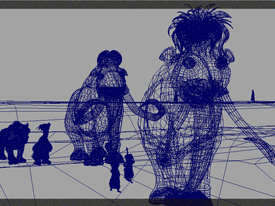
In effects, we moved so much footage through the pipeline. We didnt start our first effects shot until late August, which meant that we did all of our work in about five months. We had to do a lot of hiring. We went from around 11 people on Robots to 23 on my team for this film. We had to do a lot of simplification and be smart and clever with our camera so that we were only shooting interaction with the characters where it really mattered.
Eventually, we came up with a way that allowed us to drip water off the edge of the fur, but by the time it was ready to be used we were almost done with the shots. What we ended up using was a very brute force approach that applied little drips to key areas like the bottom of Mannys trunk.
For inspiration, the effects team went to the Bronx Zoo to observe nature and the way things work in the real world. But they also referenced a lot of movies and TV everything from The Day After Tomorrow to Davey and Goliath. I think it was probably a shot in The Incredibles that was a revelation for me and that was when hes stalking these two guys in a little pod car and hurls one of them over a cliff into the water below. Theres just a bunch of white particles that sell the interaction. You dont see white ripples. And after looking at that shot several times, I realized that they got away with murder there. But the first couple of times, you bought it they had just enough detail to make it convincing. So we started using little ideas like turning away from the camera quickly, or shooting the element a little lower to help us nail the style that we needed and that level of interactivity in terms of detail. It was reassuring to us that we didnt have to set the bar too high to have this be a successful integration of effects and characters and water.
Bill Desowitz is editor of VFXWorld.
| Attachment | Size |
|---|---|
| 2862-iceage2miscrat.mov | 4.12 MB |
| 2862-iceage2miscrat.mov | 4.12 MB |









